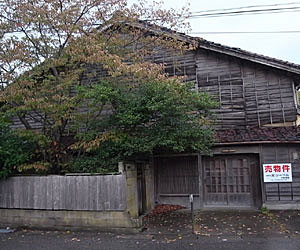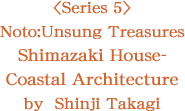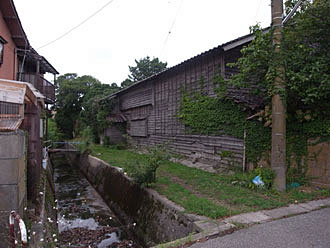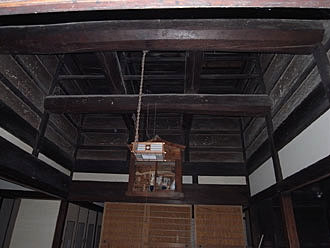

|
 |
At handmadejapan.com we have been introducing various skilled handmade crafts since 2000. We have sort to expose the essence of those crafts which are characterized and deeply rooted in the areas where the craftspeople live, are affect by local climate and history. And at the same time there has been a chance to enjoy the individual qualities of ceramics both rustic and fine, cloth, paper and items made of bamboo, too. In a series of ten articles under the heading of Noto: Unsung Treasures, the architect Shinji Takagi, who was born and raised in Wajima in Ishikawa prefecture, seeks to identify some of the interesting buildings and their background, old local customs and various pieces of engaging landscape, all of which might not make it into a tourist guide but are nevertheless of considerable interest. On the Noto Peninsula there are still many of what we might call “coastal style” buildings. They are simple structures characterized by their facades made up of a gable end and a low lean-to addition with an entrance. These two elements come in a variety of combinations and their relationship varies considerably according to the size and use of the building. One of them can be found in Takojima situated some five kilometers north of the Iida district of Suzu city. Known as the Shimazaki house, it once flourished with the marine trade that developed along the Japan Sea coast as a result of trade fostered by the Kitamae sailing ships, which plied the waters between the prosperous areas to the west of Noto and ports to the north as well as Hokkaido. Sadly the property is now rather rundown since it has fallen into disuse and the two storehouses and the lean-to in particular are in a sorry state. Despite this, the main building and its pine in the front garden still give the property an air of composure prevalent in this coastal style of architecture and the building remains one of Takojima’s unsung treasures. The part of the coast which the Shimazaki house faces is known as the Sanzo no Hama. Formally it seems that a breakwater that was called Ishigura was built here as a mooring and seawall. It stretched out toward a small island called Benten-jima standing someway off shore. Reclamation done here in the late 1950s means we can now only imagine how beautiful this stretch of coastline would have looked with sailing ships and the distant Benten-jima. |
 
|
Toward the end of the 19th century the Shimazaki household owned two Sengoku sailing ships and business was good. Although such Kitamae ships principally carried cargo they were also used to ferry both passengers and mail. It seems that the Shimazaki ships had a particularly good reputation as ferries and tradition has it that anyone thinking of heading north to Hokkaido was advised to sail with the Shimazakis. It seems that they were not only in the cargo business as the building also provided lodging for seafarers. In fact, the main part of the property is singularly arranged internally to provide such accommodation and even has a “hidden room” as one of its distinctive features. The story goes that this room would have provided a young person with a place to hide from their parents before heading north in search of opportunity and would even have been secure if there was a spot-check. A building with such a rich history as this is a rarity not only in Takojima but in Suzu city as a whole and should really be conserved as a cultural property but at present there are no signs of that happening. The fact that the Noto Peninsula is an area of depopulation is a well-known fact. Recently, however, there has been an increase in the number of young people who have been attracted to the unspoiled coastline and natural environment of parts of Suzu city and have set up home there. Having built up a good relationship with the locals, there are couples living there now who have begun to farm respecting nature, while others have used empty properties to set up workshops or to open galleries. The peninsula has often been seen as a place where there was no work for the young. These in-comers, however, are now making it a land of opportunity for themselves. Shinji Takagi---Architect Born in Wajima in 1942. Worked on many projects using local materials and true lacquer for shops, houses and a variety of interior design schemes. Principal work includes Yuyado Sakamoto in Suzu: the repair and renovation of the true lacquer craftsman's house, Nurishi no Ie in Wajima: Meiso no Yakata in Toga, Toyama prefecture: the store Kombuya Shirai in Nanao and Kanazawa: a store selling Japanese candles, Takazawa Shoten in Nanao. Member on the Wajima City Council for the Protection of Cultural Properties Committee. Director of the NPO, Ishikawa Reed Thatch Culture Study Group. Bill Tingey---Translator Chief Designer to David Hicks in London before moving to Japan in 1976 and gaining a Masters Degree in History of Architecture. Worked in Japan as a photographer, designer, writer and translator. Returned to UK to continue work in 2000. |
| (2014/12 Yuko Yokoyama) |
|
(C)Copyright 2004 Jomon-sha Inc, All rights reserved. |